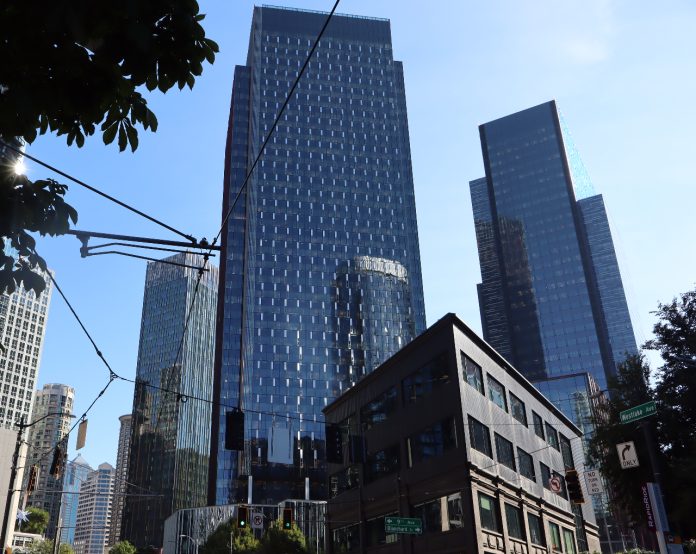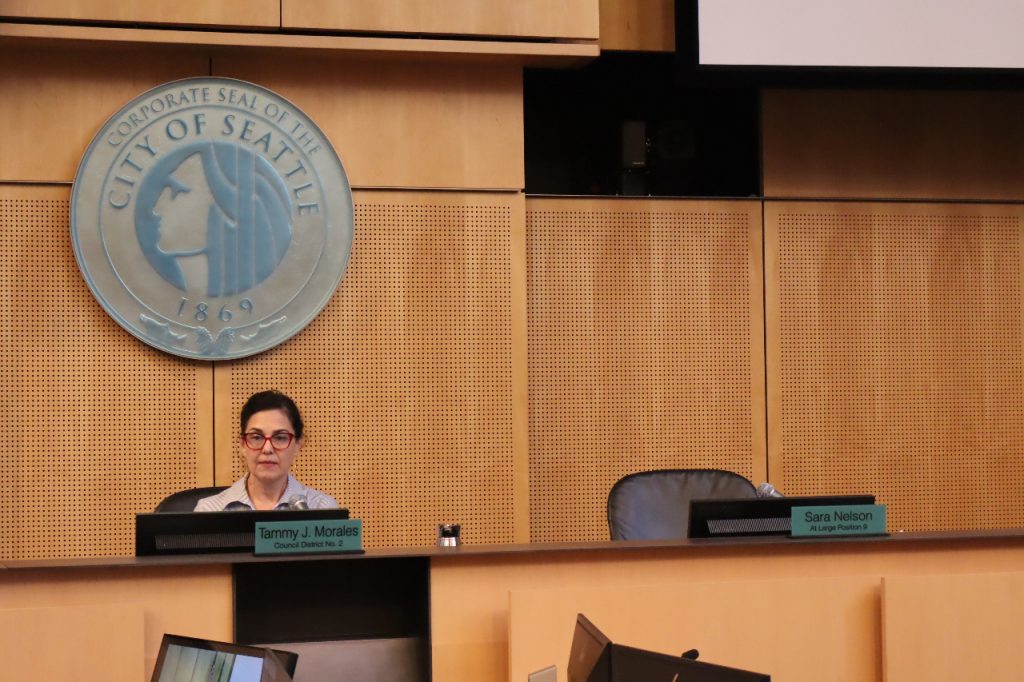
The proposal to temporarily let some types of development in Seattle’s downtown neighborhoods skip the onerous design review process was greeted with a mix of support and skepticism from City Council this week. Wednesday’s public hearing in the land use committee was the first discussion of the idea after the Harrell Administration proposed the bill earlier this year, as part of its broader plan to activate downtown in the long-term.
Under the bill, proposed building projects that include at least half of their floor area as residential or hotel space, or include any research and development lab uses, would be exempt from having to go through the full design review process, controlled by all-volunteer boards. Instead, those projects would be reviewed by staff at the Seattle Department of Construction and Inspections (SDCI).
Only projects within Downtown, Uptown, South Lake Union, First Hill, and a small slice of SoDo’s industrial area north of Royal Brougham Way would qualify for the exemption, and the exemption would sunset three years after it takes effect. Areas inside the Pioneer Square, Chinatown-International District, and Pike Place Market historic districts wouldn’t be included.

Developers wanting to build projects downtown would likely be incentivized to get their applications in during that timeframe, even if they aren’t fully ready to move forward. Another major benefit to applicants is that projects approved by SDCI during this period could not be appealed to the city’s Hearing Examiner, something that can add even more time to projects and a tactic that groups trying to halt projects have long utilized. According to the City, average completion times for full design review can total more than two years, not including any appeal time. That time wouldn’t be fully saved, with administrative review still taking time, but the difference could be substantial. A recent citywide analysis found that full design review adds nine months delay compared to administrative review, on average, and downtown has some of the most complex projects.
Unusually, the memo distributed to councilmembers from the council’s independent central staff appeared openly skeptical of the proposal, questioning whether the Harrell Administration had even articulated what it is trying to accomplish with the bill.
“It is unclear what problem [the bill] seeks to solve,” the memo, written by longtime staffer Ketil Freeman, stated, noting that the downtown neighborhoods in question have the additional capacity, on paper, to accommodate 41,000 additional homes and 110,000 additional jobs. However, homes and jobs can’t come to fruition if projects do not pencil out as feasible for the builders. So, it’s not clear how relevant the zoned capacity of downtown is in this context.
Council President Sara Nelson, not a member of land use committee and joining as a guest, acted as its biggest advocate at Wednesday’s meeting, with no one present from Mayor Harrell’s office to speak to the bill’s role in the broader Downtown Activation Plan.
“I have always said that we need to better align our regulatory environment to meet our policy goals. So when it comes to housing, that means, if we want more housing, we have to make it cheaper and easier to build,” Nelson said.
The council president took issue with Freeman’s characterization of downtown’s capacity in the staff memo, and noted that design review comes with real costs for developers. She pointed to council’s decision to exempt projects from design review when they produce rent-restricted Mandatory Housing Affordability (MHA) units on site as recognition of the hurdles the program creates — and the incentive a faster permitting track creates.
“More salient to me is the concern of our constituents that do say that we are taking away the ability for them to weigh in on the design in them the appearance of a building,” Nelson said. “And I take that seriously, but we have permanently citywide eliminated design review for market-rate development with on-site [MHA] performance and so, I don’t know if the same argument was made at that time, but again, it’s about consistency in how we in how we try to incentivize what I think everybody agrees is a positive.”
Committee chair Tammy Morales was more skeptical of the bill, suggesting that staff time at SDCI would be better spent working on more systemic fixes to design review. By the end of 2025, Seattle needs to revise the entire design review program to align with House Bill 1293, changing its design standards for every single neighborhood to be more objective, and updating the process to only include one meeting. Design review boards can require three or more meetings to review a single project under the current design review program.

Morales brought up the challenges of quantifying the costs that design review adds, noting that developers are loath to publicize detailed financial information for a project, or a “pro forma” in developer lingo.
“I know there’s a lot of talk about design review increasing costs of production. There’s really no evidence to support that, because pro formas of projects were not available for analysis,” Morales said. “So I’m sure there is some connection there, it’s just a hard point for us to prove because we don’t have pro formas from projects that can help us see how these delays might add to cost. I would love [it] if there are developers out there who are interested in sharing that information so that we can really back up what we’re saying with data that would be helpful.”
Despite the lack of public pro formas, housing advocates have been able to link design review to significant costs, both in terms of fees paid to architecture firms to produce design review packets and present to boards and in terms of delay, which adds carrying costs while they wait and inflates project costs when builders are finally able to break ground.
Councilmember Dan Strauss called the bill “prudent,” limited in geographic scope, development scope, and time.
“This gives us a nice pilot to prepare us for the future changes that need to be made [to design review]. And the scope of where we are is a heavily developed area, which means that there’s not a lot of potential, as compared to — if this bill was being applied to Neighborhood Residential [zones] today, I would have a lot more concerns,” Strauss said.
Meanwhile Councilmember Bob Kettle, whose district encompasses most of the area that would fall under this bill, doesn’t sit on the land use committee and didn’t weigh in directly. But in a discussion at the transportation committee the day prior, Kettle brought up the topic of design review on his own, seeming to throw shade on this bill.
“I recognize design review is a dirty word in some communities, but I favor design review because it really brings in the communities,” Kettle said. “And guess what, there’s a lot of smart ideas that come out of the community, and I know that from personal experience in terms of the Queen Anne Community Council but also Uptown Alliance and South Lake Union Community Council.”
During the public hearing, numerous commenters asserted that exempting projects from design review would be giving up authority from elected councilmembers to unelected city staffers, despite the fact that design review board members are not elected either. Last week, the Seattle Times published an op-ed by Belltown resident Megan Kruse opposing the bill, with Kruse accusing the city of trying to “mute the neighbors” of planned developments, without mentioning the prominent role that Kruse has played in blocking projects downtown, preventing millions of dollars from being contributed to fund affordable housing.
The land use committee has just one opportunity to vote on the bill before suspending its meetings for the fall budget season, which ultimately means that if there’s not a vote on September 18, the bill would be punted into December, at the earliest. With Council President Sara Nelson behind the proposal, it seems to have enough support for ultimate approval, but whether councilmembers are able to get their questions answered within the next two weeks is another question.
Ryan Packer has been writing for The Urbanist since 2015, and currently reports full-time as Contributing Editor. Their beats are transportation, land use, public space, traffic safety, and obscure community meetings. Packer has also reported for other regional outlets including BikePortland, Seattle Met, and PubliCola. They live in the Capitol Hill neighborhood of Seattle.

